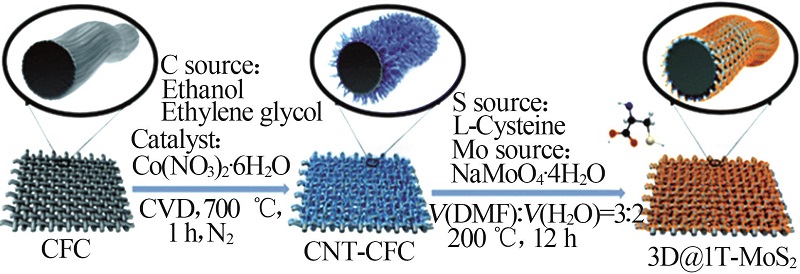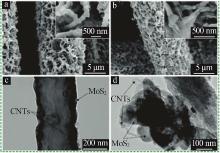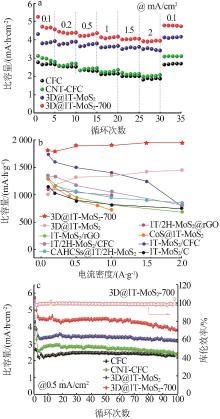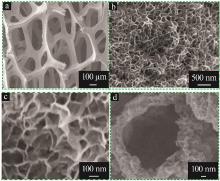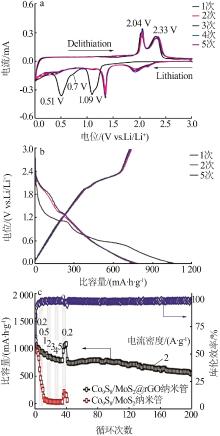Inorganic Chemicals Industry ›› 2022, Vol. 54 ›› Issue (10): 87-95.doi: 10.19964/j.issn.1006-4990.2021-0619
• Reviews and Special Topics • Previous Articles Next Articles
Research progress on molybdenum disulfide-based anode materials for lithium-ion batteries
WANG Wei1,2( ),LIU Wei1,2(
),LIU Wei1,2( ),WU Yang1,2,YANG Shenshen1
),WU Yang1,2,YANG Shenshen1
- 1. School of Materials Science and Engineering, Henan University of Science and Technology, Luoyang 471023, China
2. National Joint Engineering Research Center for Abrasion Control and Molding of Metal Materials
-
Received:2021-10-18Online:2022-10-10Published:2022-11-03 -
Contact:LIU Wei E-mail:1813209696@qq.com;liuweimse@163.com
CLC Number:
Cite this article
WANG Wei,LIU Wei,WU Yang,YANG Shenshen. Research progress on molybdenum disulfide-based anode materials for lithium-ion batteries[J]. Inorganic Chemicals Industry, 2022, 54(10): 87-95.
share this article
Table 1
Electrochemical performance data of MoS2 and typical MoS2 based composite as anode materials"
| 材料体系 | 形貌 | 层间距(hkl) | 合成方法 | 起始比容量(电流密度) | 循环稳定性 |
|---|---|---|---|---|---|
| MoS2[ | 纳米片 | 0.62 nm(002) | 加热-搅拌法 | 732 mA·h/g(0.1 A/g) | 循环100周后比容量小于200 mA·h/g |
| MoS2/C[ | 类石墨烯 | 0.62 nm(002) | 水热法 | 962 mA·h/g(—) | 循环100周后比容量保持率为95% |
| MoS2/C[ | 纳米球 | — | 水热法 | 1 307.8 mA·h/g (0.1 A/g) | 循环500周后比容量 为439 mA·h/g(1 A/g) |
| C@MoS2@C[ | 纳米带 | 0.63 nm(002) | 水热-分解法 | 1 025.5 mA·h/g (0.2 A/g) | 循环100周后比容量保持率为99% |
| MoS2/MBC[ | 纳米片 | 0.61 nm(003) | 水热法 | 1 867 mA·h/g(0.2 A/g) | 循环100周后比容量为672 mA·h/g |
| CDs/MoS2[ | 泡沫状 | 0.96 nm(002) | 水热-碳化法 | 1 400 mA·h/g(0.1 A/g) | 循环100周后比容量为1 064 mA·h/g |
| MoS2-CNT[ | 纳米管 | 0.83 nm(002) | CVD-水热法 | 1 400 mA·h/g(0.1 mA/cm2) | 循环100周后比容量为1 391 mA·h/g |
| 1T/2H-MoS2/CFC[ | 纳米片 | 0.82~0.91nm(002) | 水热法 | 1 546 mA·h/g (0.1A/g) | 循环120周后比容量保持率为94.1% |
| MoS2/rGO[ | 中空微球 | 0.62 nm(002) | 水热法 | 760 mA·h/g(0.5 A/g) | 循环100周后比容量保持率为99.15% |
| HC-MoS2@GF[ | 蜂巢状 | 0.64 nm(002) | 液相法-CVD | 1 110 mA·h/g(0.2 A/g) | 循环40周后比容量保持率为99% |
| Sn/MoS2[ | 纳米花 | 0.62 nm(002) | 溶剂热法 | 1 000 mA·h/g(0.2 A/g) | 循环100周后比容量保持率接近100% |
| Si@C@MoS2[ | 三明治结构 | 0.633 nm(002) | 溶胶凝胶-机械 搅拌-水热工艺 | 1 365.7 mA·h/g(0.5 A/g) | 循环500周后比容量保持率为81.5% |
| MoS2/Mo2TiC2T x[ | 片状 | 0.69 nm | 液相混合 | 646 mA·h/g(0.1 A/g) | 循环500周后比容量保持率为86% |
| MoS2-TiN[ | 条纹状 | — | 磁控溅射 | 700 mA·h/g(0.1 A/g) | 循环300周后比容量保持率为89% |
| MoS2/TiO2[ | 微米花状 | — | 水热法 | 410.8 mA·h/g(0.8 A/g) | 循环300周后比容量保持率为88% |
| Li3VO4/MoS2[ | 纳米片 | 0.268nm(101) | 溶剂热法 | 950 mA·h/g(0.1 A/g) | 循环100周后比容量为789.1 mA·h/g |
| C@MoS2@TiO2[ | 纳米管 | — | 模板法-溶剂热法 | 455.2 mA·h/g(2 A/g) | 循环1 000周后比容量为455.2 mA·h/g |
| SnO2@C@MoS2[ | 花瓣状 | 0.62 nm(002) | 水热法 | 1 500 mA·h/g(0.1 A/g) | 循环200周后比容量为1 082 mA·h/g |
| Co9S8/MoS2@rGO[ | 中空纳米管 | 0.65 nm(002) | 模板法-自组装 | 1 140 mA·h/g(0.1 A/g) | 循环180周后比容量为807 mA·h/g |
| [1] | WU Ling, ZHENG Jie, WANG Liang, et al.PPy-encapsulated SnS2 nanosheets stabilized by defects on a TiO2 support as a durable anode material for lithium-ion batteries[J].Angewandte Chemie (International Ed.in English), 2019, 58(3): 811-815. |
| [2] | YAO Tianhao, WANG Hongkang, WANG Jinkai, et al.Metal-organic framework derived Ge/TiO2@C nanotablets as high-performance anode for lithium-ion batteries[J].ChemistrySelect, 2019, |
| 4(35): 10576-10580. | |
| [3] | WANG Zuolu, FENG Guojin, ZHEN Dong, et al.A review on online state of charge and state of health estimation for lithium-ion batteries in electric vehicles[J].Energy Reports, 2021, 7: 5141-5161. |
| [4] |
HUANG Lujun, LI Tengfei, LIU Qinglei, et al.Fluorine-free Ti3C2T x as anode materials for Li-ion batteries[J].Electrochemistry Communications, 2019,104.Doi:10.1016/j.elecom.2019.05.021.
doi: 10.1016/j.elecom.2019.05.021 |
| [5] | GUO X, XIE K, WANG Y, et al.Reduced graphene oxide-coated 3D interconnected SiO2 nanoparticles with enhanced lithium storage performance[J].International Journal of Electrochemical Science, 2018, 13(6): 5645-5653. |
| [6] | CAO Bokai, LIU Ziqi, XU Chunyang, et al.High-rate-induced capacity evolution of mesoporous C@SnO2@C hollow nanospheres for ultra-long cycle lithium-ion batteries[J].Journal of Power So- urces, 2019, 414: 233-241. |
| [7] | WANG Wenzhao, ZENG Xiangbin, WARNER J H, et al.Photoresponse-bias modulation of a high-performance MoS2 photodetector with a unique vertically stacked 2H-MoS2/1T@2H-MoS2 structu-re[J].ACS Applied Materials & Interfaces, 2020, 12(29): 33325-33335. |
| [8] |
LEI Zhendong, ZHAN Jing, TANG Liang, et al.Recent development of metallic(1T) phase of molybdenum disulfide for energy conversion and storage[J].Advanced Energy Materials, 2018, 8(19).Doi:10.1002/aenm.201703482 .
doi: 10.1002/aenm.201703482 |
| [9] | NAVAS J, MARTÍNEZ-MERINO P, SÁNCHEZ-CORONILLA A, et al.MoS2 nanosheets vs.nanowires:Preparation and a theoretical study of highly stable and efficient nanofluids for concentrating solar power[J].Journal of Materials Chemistry A, 2018, 6(30): 14919-14929. |
| [10] |
RADHAKRISHNAN S, RAJ K A S, KUMAR S R, et al.Energy storage performance of 2D MoS2 and carbon nanotube heterojunctions in symmetric and asymmetric configuration[J].Nanotechnology, 2021, 32(15).Doi:10.1088/1361-6528/abd05b .
doi: 10.1088/1361-6528/abd05b |
| [11] | LI Yang, JIANG Song, QIAN Yong, et al.2D interspace confined growth of ultrathin MoS2-intercalated graphite hetero-layers for high-rate Li/K storage[J].Nano Research, 2021, 14(4): 1061-1068. |
| [12] | CHEN Runfeng, LIN Cheng, YU Huan, et al.Templating C60 on MoS2 nanosheets for 2D hybrid van der waals p-n nanoheterojunctions[J].Chemistry of Materials, 2016, 28(12): 4300-4306. |
| [13] |
ZHAO Yangqiang, ZHANG Ziying, ZHANG Huizhen, et al.Three-dimensional PrGO-based sandwich composites with MoS2 flowers as stuffings for superior lithium storage[J].Frontiers in Chemistry, 2020,8.Doi:10.3389/fchem.2020.00094 .
doi: 10.3389/fchem.2020.00094 |
| [14] | LOU Xiaoge, LIU Zhongliang, HOU Junxian, et al.Modification of the anodes using MoS2 nanoflowers for improving microbial fuel cells performance[J].Catalysis Today, 2021, 364: 111-117. |
| [15] | LIU Yueru, HU Kunhong, HU Enzhu, et al.Double hollow MoS2 nano-spheres:Synthesis,tribological properties,and functional conversion from lubrication to photocatalysis[J].Applied Surface Science, 2017, 392: 1144-1152. |
| [16] | CHANG Kun, CHEN Weixiang, MA Lin, et al.Graphene-like MoS2/amorphous carbon composites with high capacity and excellent stability as anode materials for lithium ion batteries[J].Journal of Materials Chemistry, 2011, 21(17): 6251-6257. |
| [17] | 艾经伟, 杨尊先, 郭太良.分级结构的碳/二硫化钼纳米带的制备及其锂电性能研究[J].真空科学与技术学报, 2018, 38(2): 132-139. |
| AI Jingwei, YANG Zunxian, GUO Tailiang.Synthesis and Li-ion storage properties of hierarchical C-coated MoS2 nanobelts[J].Chinese Journal of Vacuum Science and Technology, 2018, 38(2): 132-139. | |
| [18] |
XU Yonghang, ZHANG Congcong, KUANG Shaojie, et al.Facile synthesis and electrochemical performances of activated bamboo charcoal supported MoS2 nanoflakes as anodes materials for lithium-ion batteries[J].Journal of Electroanalytical Chemistry, 2019,847.Doi:10.1016/j.jelechem.2019.113265 .
doi: 10.1016/j.jelechem.2019.113265 |
| [19] | WU Junxiong, CIUCCI F, KIM J K.Molybdenum disulfide based nanomaterials for rechargeable batteries[J].Chemistry(Weinheim an Der Bergstrasse,Germany), 2020, 26(29): 6296-6319. |
| [20] | LEI Zhendong, YU Xue, ZHANG Yong, et al.Thermally stable fishnet-like 1T-MoS2/CNT heterostructures with improved electrode performance[J].Journal of Materials Chemistry A, 2021, 9(8): 4707-4715. |
| [21] | XUE Haoliang, JIAO Qingze, DU Jinyu, et al.Hollow MoS2/rGO composites as high-performance anode materials for lithium-ion batteries[J].Ionics, 2019, 25(10): 4659-4666. |
| [22] | LONG Fei, CHEN Yi, WU Caihong, et al.Unique three-dimensional hierarchical heterogeneous MoS2/graphene structures as a high-performance anode material for lithium-ion batteries[J].Ionics, 2021, 27(5): 1977-1986. |
| [23] | WANG Jin, LIU Jilei, CHAO Dongliang, et al.Self-assembly of honeycomb-like MoS2 nanoarchitectures anchored into graphene foam for enhanced lithium-ion storage[J].Advanced Materi- als(Deerfield Beach,Fla.), 2014, 26(42): 7162-7169. |
| [24] |
ZHANG Wenlan, ZHENG Maojun, LI Fanggang, et al.SnO x /graphene anode material with multiple oxidation states for high-performance Li-ion batteries[J].Nanotechnology, 2021, 32(19).Doi:10.1088/1361-6528/abe2c9 .
doi: 10.1088/1361-6528/abe2c9 |
| [25] | LU Lin, MIN Feixia, LUO Zhaohui, et al.Synthesis and electrochemical properties of tin-doped MoS2(Sn/MoS2) composites for lithium ion battery applications[J].Journal of Nanoparticle Research, 2016, 18(12): 1-12. |
| [26] |
ZHAO Qian, ZHU Qizhen, MIAO Jiawei, et al.Lithium-ion batteries:Flexible 3D porous MXene foam for high-performance lithi-um-ion batteries(small 51/2019)[J]. Small, 2019, 15(51).Doi:10.1002/smll.201970276 .
doi: 10.1002/smll.201970276 |
| [27] | 齐新, 陈翔, 彭思侃, 等. MXenes二维纳米材料及其在锂离子电池中的应用研究进展[J].材料工程, 2019, 47(12): 10-20. |
| QI Xin, CHEN Xiang, PENG Sikan, et al.Research progress on two-dimensional nanomaterials MXenes and their application for lithium-ion batteries[J].Journal of Materials Engineering, 2019, 47(12): 10-20. | |
| [28] | CHEN Chi, XIE Xiuqiang, ANASORI B, et al.MoS2-on-MXene heterostructures as highly reversible anode materials for lithium-ion batteries[J].Angewandte Chemie(International Ed.in English), 2018, 57(7): 1846-1850. |
| [29] | MOON S H, KIM S J, KIM M C, et al.MoS2-TiN nanostructured electrodes fabricated using co-sputtering deposition method for high-performance lithium-ion batteries[J].Journal of Alloys and Compounds, 2018, 741: 1048-1054. |
| [30] | CHENG Hui, SHAPTER J G, LI Yongying, et al.Recent progress of advanced anode materials of lithium-ion batteries[J].Journal of Energy Chemistry, 2021, 57: 451-468. |
| [31] |
FAN Yicheng, CHEN Xuhui, ZHANG Kun, et al.A coordinated regulation strategy to improve electronic conductivity and Li-ion transport for TiO2 lithium battery anode materials[J].Journal of Alloys and Compounds, 2021,860.Doi:10.1016/j.jallcom.2020.158282 .
doi: 10.1016/j.jallcom.2020.158282 |
| [32] | CHEN Biao, MENG Yuhuan, SHA Junwei, et al.Preparation of MoS2/TiO2 based nanocomposites for photocatalysis and rechar-geable batteries:Progress,challenges,and perspective[J].Nanoscale, 2017, 10(1): 34-68. |
| [33] | ZHANG Yingjie, ZHAO Shaobo, ZENG Xiaoyuan, et al.TiO2–MoS2 hybrid nano composites with 3D network architecture as binder-free flexible electrodes for lithium ion batteries[J].Journal of Materials Science:Materials in Electronics, 2017, 28(13): 9519-9527. |
| [34] | ZHOU Yu, LIU Yong, ZHAO Wenxia, et al.Growth of vertically aligned MoS2 nanosheets on a Ti substrate through a self-supported bonding interface for high-performance lithium-ion batteries:A general approach[J].Journal of Materials Chemistry A, 2016, 4(16): 5932-5941. |
| [35] | PHAM-CONG D, CHOI J H, YUN J, et al.Synergistically enhanced electrochemical performance of hierarchical MoS2/TiNb2O7 hetero-nanostructures as anode materials for Li-ion batteries[J].ACS Nano, 2017, 11(1): 1026-1033. |
| [36] | ZHANG Mengqi, BAI Xue, LIU Yangyang, et al.Solvothermal processed Li3VO4/MoS2 composites and its enhanced electrochemical performance as lithium battery anode materials[J].Applied Surface Science, 2019, 469: 923-932. |
| [37] | LI Junfeng, HAN Lu, ZHANG Xinlu, et al.Multi-role TiO2 layer coated carbon@few-layered MoS2 nanotubes for durable lithium storage[J].Chemical Engineering Journal, 2021,406.Doi:10.1016/j.cej2020.126873. |
| [38] |
ZHANG Peng, LIU Yang, ZHOU Min, et al.Rationally designed C/Co9S8@SnS2 nanocomposite as a highly efficient anode for lithium-ion batteries[J].Nanotechnology, 2020, 31(39).Doi:10.1088/1361-6528/ab9a72 .
doi: 10.1088/1361-6528/ab9a72 |
| [39] | 刘瑜琳.MoS2纳米材料制备及其电化学性能研究[D].哈尔滨:哈尔滨工业大学, 2018. |
| LIU Yulin.Preparation of MoS2 nanomaterials and study on their electrochemical properties[D].Harbin:Harbin Institute of Technology, 2018. | |
| [40] |
FOLEY S, GEANEY H, BREE G, et al.Copper sulfide(Cu x S) nanowire-in-carbon composites formed from direct sulfurization of the metal-organic framework HKUST-1 and their use as Li-ion battery cathodes[J].Advanced Functional Materials, 2018, 28(19).Doi:10.1002/adfm.201800587 .
doi: 10.1002/adfm.201800587 |
| [41] | LIU Yayuan, GENG Hongbo, ANG E H, et al.Hierarchical nanotubes constructed by Co9S8/MoS2 ultrathin nanosheets wrapped with reduced graphene oxide for advanced lithium storage[J].Chemistry,an Asian Journal, 2019, 14(1): 170-176. |
| [42] | CHOI J H, KIM M C, MOON S H, et al.Enhanced electrochemical performance of MoS2/graphene nanosheet nanocomposites[J].RSC Advances, 2020, 10(32): 19077-19082. |
| [43] |
LIU Hongdong, LIN Ye, ZHANG Lei.Hierarchical porous MoS2/C nanospheres self-assembled by nanosheets with high electrochemical energy storage performance[J].Nanoscale Research Letters, 2020, 15(1).Doi:10.1186/s11671-020-03427-5 .
doi: 10.1186/s11671-020-03427-5 |
| [44] | MA Beibei, CHEN Shuijiao, HUANG Yewei, et al.Electrochemical lithium storage performance of three-dimensional foam-like biocarbon/MoS2 composites[J].Transactions of Nonferrous Metals Society of China, 2021, 31(1): 255-264. |
| [45] | LIN Xiaoping, XUE Dongyang, ZHAO Longze, et al.In-situ growth of 1T/2H-MoS2 on carbon fiber cloth and the modification of SnS2 nanoparticles:A three-dimensional heterostructure for high-performance flexible lithium-ion batteries[J].Chemical Engineering Journal, 2019, 356: 483-491. |
| [46] | ZHANG Xinlin, HUANG Liwu, ZENG Pan, et al.Hierarchical MoS2 anchored on core-shell Si@C with increased active-sites and charge transfer for superior cycling and rate capability in lithium-ion batteries[J].Chemical Engineering Journal, 2019, 357: 625-632. |
| [47] |
MAO Peiyuan, WANG Yong, GUO Wenbin, et al.Morphology-controlled synthesis and lithium storage properties of SnO2@C@MoS2 hollow nanospheres with petaloid and granular MoS2 nanosheets as the external layer in different solvents[J].Journal of Alloys and Compounds, 2021,850.Doi:10.1016/j.jallcom.2020.156745 .
doi: 10.1016/j.jallcom.2020.156745 |
| [48] | PARK J, JOO S H, KIM Y J, et al.Organic semiconductor cocrystal for highly conductive lithium host electrode[J].Advanced Functional Materials, 2019, 29(32).Doi:10.1002/adfm.201902888.(上接第45页) |
| [49] | LI Jun, GAO Shiyang, XIA Shuping, et al.Thermochemistry of hydrated magnesium borates[J].The Journal of Chemical Thermodynamics, 1997, 29(4): 491-497. |
| [50] | CHEN Shangqing, WANG Mengxue, HU Jiayin, et al.Phase equilibria in the aqueous ternary systems(NaCl+NaBO2+H2O) and (Na2SO4+NaBO2+H2O) at 298.15 K and 0.1 MPa[J].Journal of Chemical and Engineering Data(the ACS Journal for Data), 2018, 63(12): 4662-4668. |
| [51] |
CUI Wanjing, HOU Hongfang, HU Jiayin, et al.Phase equilibria and phase diagrams for the aqueous ternary system containing sodium,chloride,and metaborate ions at 288.15 and 308.15 K and 0.1 MPa[J].Journal of Chemistry, 2019.Doi:10.1155/2019/ 1983051 .
doi: 10.1155/2019/ 1983051 |
| [52] |
YANG Lan, LI Dan, ZHANG Tao, et al.Thermodynamic phase equilibria in the aqueous ternary system NaCl-NaBO2-H2O:Experimental data and solubility calculation using the Pitzer mo-del[J].The Journal of Chemical Thermodynamics, 2020,142.Doi:10.1016/j.jct.2019.106021 .
doi: 10.1016/j.jct.2019.106021 |
| [53] | BU Baihui, LI Long, ZHANG Nan, et al.Solid-liquid metastable phase equilibria for the ternary system(Li2SO4+K2SO4+H2O) at 288.15 and 323.15 K,p=0.1 MPa[J].Fluid Phase Equilibria, 2015, 402: 78-82. |
| [54] | WANG Shiqiang, YANG Juan, SHI Chuncheng, et al.Solubilities,densities,and refractive indices in the ternary systems(LiBO2+NaBO2+H2O) and(LiBO2+KBO2+H2O) at 298.15 K and 0.1 MPa[J].Journal of Chemical & Engineering Data, 2019, 64(7): 3122-3127. |
| [55] | 中国科学院青海盐湖研究所分析室.卤水和盐的分析方法[M].2版.北京:科学出版社, 1988. |
| [56] | 杨琴, 李君, 李恒欣, 等. 三元体系Na2B4O7-NaHCO3-H2O和Na2CO3-NaBO2-H2O等温溶解度研究[J].盐湖研究, 2001, 9(4): 24-29. |
| YANG Qin, LI Jun, LI Hengxin, et al.Study on the isothermal solubility for the ternary system Na2B4O7-NaHCO3-H2O and Na2CO3-NaBO2-H2O[J].Journal of Salt Lake Research, 2001, 9(4): 24-29. |
| [1] | ZHANG Shanshan, ZENG Yule, ZHANG Ting, LIN Sen, LIU Chenglin. Research progress of cathode pre-lithiation technology for lithium-ion batteries [J]. Inorganic Chemicals Industry, 2025, 57(1): 1-13. |
| [2] | ZHANG Feigang, LIU Zhongli. Study on application of CuO/g-C3N4 composites in organic dye degradation and supercapacitors [J]. Inorganic Chemicals Industry, 2025, 57(1): 129-136. |
| [3] | TIAN Peng, ZHANG Haoran, XU Jingang, MOU Chenxi, XU Qianjin, NING Guiling. Study on aluminum sol modified anode and cathode materials for lithium ion batteries [J]. Inorganic Chemicals Industry, 2024, 56(9): 44-53. |
| [4] | SU Baocai, ZHANG Qin, XIE Yuanjian, CAI Pingxiong, PAN Yuanfeng. Advances in synthesis methods and structural modification of LiMnFePO4 materials [J]. Inorganic Chemicals Industry, 2024, 56(7): 28-36. |
| [5] | ZHOU Xuan, LI Mengrui, CHEN Yichen, FAN Huiqiang, WANG Bin, YUAN Gang. Research progress of nickel-based phosphide composites in improving of catalytic water electrolysis for hydrogen evolution performance [J]. Inorganic Chemicals Industry, 2024, 56(4): 8-15. |
| [6] | LI Yaguang, HAN Dongzhan, QI Lijuan. Recent research on pretreatment of waste lithium-ion batteries and electrolyte recovery technology [J]. Inorganic Chemicals Industry, 2024, 56(2): 1-10. |
| [7] | HU Wenjuan, SHEN Xiaozhong, WANG Rujia, LU Lu, ZOU Lianli. Effect of annealing temperature on phase structure and electrochemical performance of hydrogen storage alloys for automotive batteries [J]. Inorganic Chemicals Industry, 2024, 56(11): 51-58. |
| [8] | LIU Jiasheng, LUO Xiaoqiang, HOU Cuihong, XUE Lingwei. Effects of fluorine doping on electrochemical behavior of LiMn0.8Fe0.2PO4/C cathode materials [J]. Inorganic Chemicals Industry, 2024, 56(11): 45-50. |
| [9] | WAN Feng, YAN Yingchun, FAN Zhuangjun. Research progress and prospect of halide solid electrolytes [J]. Inorganic Chemicals Industry, 2024, 56(11): 15-29. |
| [10] | LIU Juan, JIANG Qinglai, ZHANG Yueyi. Study on Al-Zn co-doping of 4.6 V high voltage lithium cobalt oxide cathode materials [J]. Inorganic Chemicals Industry, 2024, 56(11): 59-64. |
| [11] | PENG Weifeng, SHI Wei. Effect of Co replacing Ni on electrochemical performance of La0.8Mg0.2Ni3.8-x Co x hydrogen storage alloy for automotive batteries [J]. Inorganic Chemicals Industry, 2024, 56(11): 65-71. |
| [12] | CHEN Tiandong, ZHAO Guangzhao, HAI Chunxi, DONG Shengde, HE Xin, XU Qi, FENG Hang, YUAN Shaoxiong, MA Luxiang, ZHOU Yuan. Research and industrialization progress on coating and doping modification of lithium-rich manganese-based materials [J]. Inorganic Chemicals Industry, 2023, 55(9): 1-8. |
| [13] | LAN Yinghua, CHEN Yanmei, MA Ruixiao, ZHANG Yanhui. Preparation and photocatalytic performance of Ce-Ti oxide-attapulgite composites [J]. Inorganic Chemicals Industry, 2023, 55(4): 133-140. |
| [14] | QU Lian, LI Yuezhu, LI Mingya, WANG Zhaopei, CHEN Yanyu, LI Yineng. Study on effect of Fe2P on electrochemical performance of LiFePO4 [J]. Inorganic Chemicals Industry, 2023, 55(12): 88-94. |
| [15] | ZHOU Shiyu,HE Ting,FU Tongtong,GUO Zirui,GU Shuai,YU Jianguo. Life cycle and economic assessment of recycling spent lithium-ion batteries with hydrometallurgical process [J]. Inorganic Chemicals Industry, 2023, 55(1): 26-32. |
| Viewed | ||||||
|
Full text |
|
|||||
|
Abstract |
|
|||||
|
||

